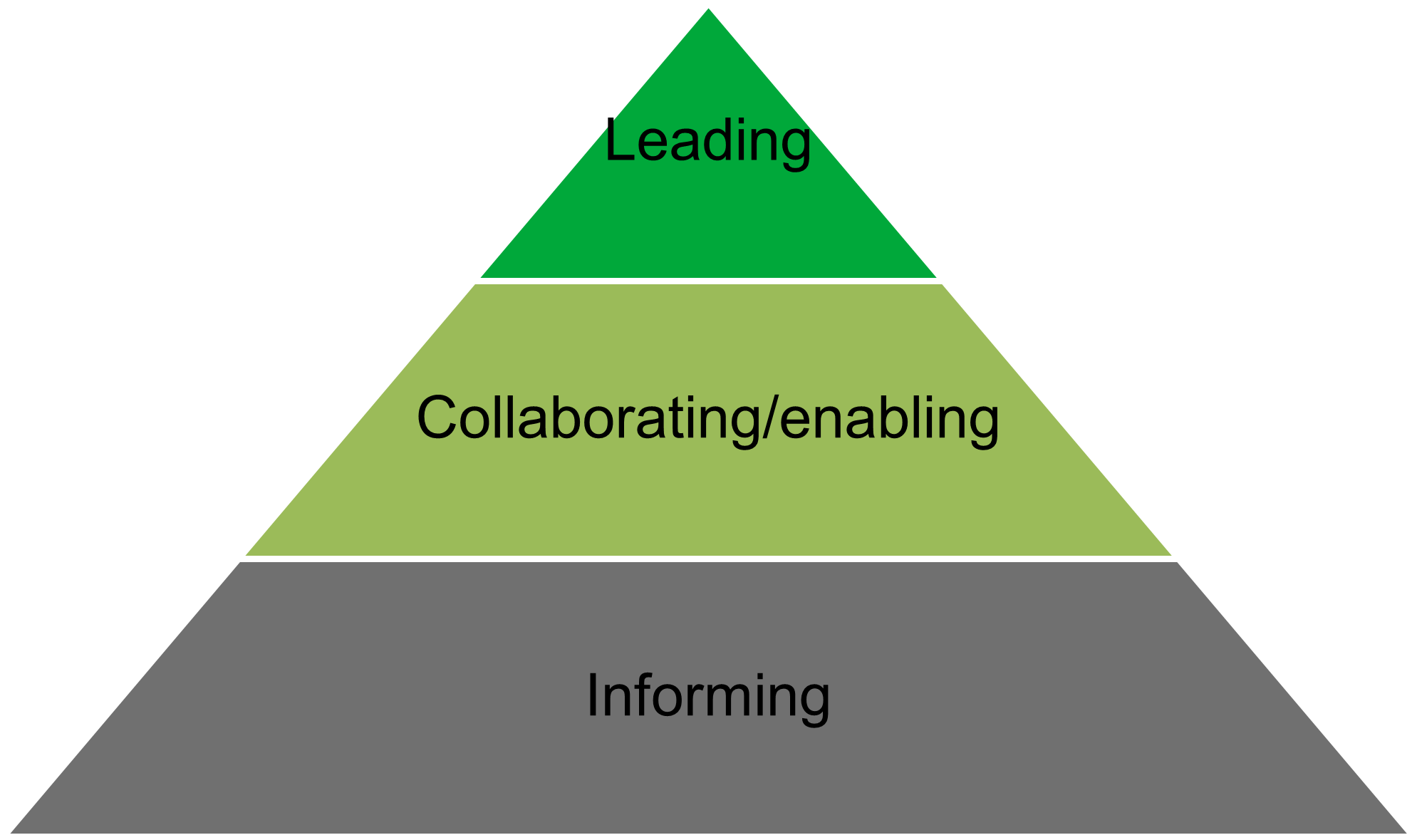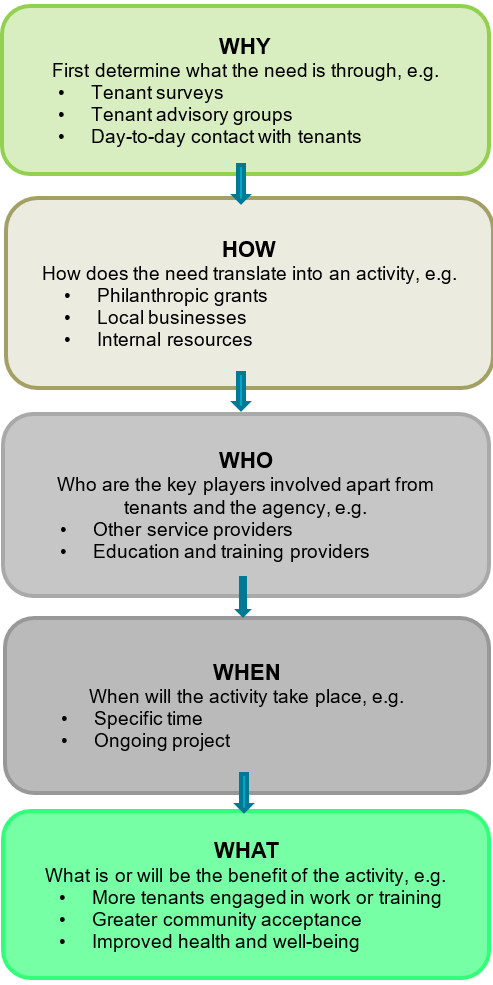Performance outcome 3 - Community Engagement Guidance
Purpose
This guidance builds on and complements evidential requirements for compliance set out in the Evidence Guidance (PDF , 439.2 KB) for Performance Outcome 3.
This guidance has two objectives.
- To ensure that registered community housing providers (CHPs) understand the performance requirements under Performance Outcome 3 (Community Engagement) of the National Regulatory Code, including how Registrars will evaluate performance in this area.
- To provide support to those CHPs seeking to invest in better practices in community engagement where they are able to do so.
This information is interpretative and not prescriptive. How and in what form CHPs choose to develop community engagement plans depends on their business and tenant circumstances.
The National Regulatory Code - Performance outcome 3
Performance Outcome 3 of the National Regulatory Code requires that the community housing provider works in partnership with relevant organisations to promote community housing and to contribute to socially inclusive communities.
Community housing providers demonstrate compliance by having up-to-date copies of community engagement policies and procedures as well as a community engagement strategy or similar document that details how the CHP works with other organisations to promote community housing. Registrars may also request other evidence such as newsletters, surveys and other marketing information, and details of partnership arrangements with support agencies and other service providers.
The NRSCH recognises that many Tier 3 providers deliver community engagement services as part of their core business and hence the provision of evidence against other performance outcomes may be agreed by the Registrar as sufficient to meet the evidence necessary for Performance Outcome 3.
Definitions
For the purposes of this guidance, social inclusion is defined as those activities that assist people to fully participate in social and economic life. These activities may include access to education, training and employment services. They may also include better connecting tenants into the local community.
Place renewal is more commonly referred to as place making or neighbourhood renewal. We have defined place renewal as strengthening the connections between people and the places they share. Place renewal activities may range from working with tenants and neighbours to improve local amenities, through to consulting with neighbours and prospective tenants on new developments and facilities.
What is Community Engagement?
Whilst there are many definitions of community engagement, the following practical approach will adopted.
“Community engagement refers to the broad range of activities and strategies registered community housing provider use in order to better connect their tenants to, and involve them in, their local communities. Community engagement provides local communities and other key stakeholders, such as service providers, philanthropic trusts, local and state government, funding bodies, as well as neighbours, with the opportunity to engage with the registered community housing provider and their tenants through a variety of means.”
Essentially, community engagement can be distilled down to all those activities and processes that are undertaken with the aim of bringing people together for a number of different purposes. One such purpose may be to ensure that neighbours who might be affected by a new development are provided with information about the development and the prospective tenants in order to allay any concerns they may have. Community engagement can therefore be a valuable educational tool enabling people to make decisions based upon evidence rather than emotion. This level of engagement may also involve neighbours as well as prospective tenants in the design of the project or in the co-location of other, desired community services, thereby empowering them.
It is important to make a distinction between community engagement and Tenant Engagement. Community Engagement involves CHPs engaging with the broader community to achieve social and economic outcomes for tenants. Tenant Engagement on the other hand, involves ensuring that tenants have a voice and are able to influence decisions made by CHPs.
Why Community Engagement?
The table below lists some of the many benefits associated with community engagement.
Table 1: Potential benefits of community engagement for tenants, the community and the registered community housing provider.
| Tenant benefits | Community benefits | CHP benefits |
|---|---|---|
Increased engagement and satisfaction |
Increased understanding of community housing | Improved relationships with service partners, philanthropic trusts, local government and other key stakeholders |
Improved community connectedness |
Greater community diversity and tolerance | Fewer complaints |
Increased feeling of safety and confidence |
Increased feeling of safety | Enhanced capacity to innovate |
Increased access to education, training and employment opportunities |
Improved local amenity | Agency is accepted/adopted by the broader community |
Community Engagement in action
Registered community housing providers may already be undertaking community engagement activities, even if they have not been identified as such. In fact, a significant number of registered community housing providers were themselves created as a consequence of community engagement and advocacy around issues to do with housing rights and homelessness.
This guidance may assist community housing providers to place those activities within a coherent framework in order to report against them in the self-assessment of performance against the National Regulatory Code.

In the diagram above, informing refers to activities undertaken by community housing provider that revolve around communication, such as developing supporter newsletters, or appearing regularly in local newspapers or advertising events on websites or through Facebook. They are also actions that can be used to inform or educate the wider community. The Registrars expect smaller providers to at least operate in this domain.
Collaborating/enabling refers to activities that the community housing provider undertakes alone or in partnership with others that actively work to overcome the social exclusion of tenants and build strong linkages with the local community. The Registrars expect Tier 2 providers to be able to at least evidence activity in this domain.
Leading refers to activities the community housing provider is undertaking that are designed to influence service provision or government policy or are activities that are breaking new ground, such as research or the development of new programs.
Suggested elements of a Community Engagement plan
The development of a community engagement plan is an important tool for community housing providers as it will enable classification of all those myriad activities that agencies undertake into one coherent format.
The following elements should be considered by providers when developing their community engagement activities.

Appendix 1: Community Engagement Activities Matrix
The following matrix illustrates how the typology of community engagement can interact with the three NRSCH performance indicators: promotion of community housing; place renewal and; social inclusion.
The matrix is a guide for registered community housing providers on how to demonstrate community engagement activities they engage in. It will also guide analysts in seeking evidence of such activities conducted by CHPs. The list of activities is for illustrative purposes only and is not intended to be exhaustive.
Indicators |
Inform |
Collaborate/Enable |
Lead |
Promotion of community housing |
Newsletters Social media Local media Websites Street parties |
Protocols with local service providers Fundraising activities with local service clubs |
Research e.g. Social Return on Investment studies Advocacy forums Newspaper articles/ research articles |
Place Renewal |
Community meetings held Short films of developments Open house days for new developments |
Community partnerships formed around specific neighbourhood issues Community projects facilitated through partnerships e.g. community gardens |
Establishment of community consultative meetings around major developments Employment of community development workers |
Social Inclusion |
Connecting tenants with local activities |
Working with philanthropic organisations to facilitate access to adult learning and other courses. |
New “wrap around” programs developed to combat social exclusion e.g. Youth Foyers Social enterprises established |
Examples
The following examples have come from registered community housing providers and are included to highlight how CHPs are demonstrating a range of community engagement activities and events they undertake.
Promotion of Community Housing
- Providers have demonstrated a range of consultation processes such as Community Champions, Tenant Connect Groups, and Tenant Reference Groups. Tenants are also often encouraged to involve themselves in information distribution processes such as involvement in the running of community newsletters and running events such as Christmas parties etc.
- CHPs working with partner organisations (including a state housing agency) to deliver a Group Home with carer accommodation designed specifically for people with a disability.
Social Inclusion
- A collaborative partnership between an ACT community housing provider and an educational institution in Canberra was established in 2017 to mutually benefit both organisations particularly the provider’s tenants and the students of the InstituteThis enabled the institution’s students over the period of four months to develop and implement service programs for the tenants which forms part of the practical assessment of the Diploma of Community Services. The provider’s Community Development manager facilitated the course enabling the students to consult and engage with the residents and tenants of a complex. The activities include arranging a morning tea and providing an opportunity for tenants to be heard and discuss community services that were of interest to them.
- The feedback identified keys areas and services that tenants are interested in to include addressing mental health issues, community safety, and services available for the aging community. The information gathered was used by the provider to engage with ACT Mental Health, ACT Policing, and Council of the Ageing. These organisations were then invited to come together to provide information sessions at the Tenants Forum held in November 2017. Both organisations have agreed to continue the partnership in 2018 and to work together to further connect tenants to educational training to upskill and increase tenants’ opportunity to gain employment.
- One provider is involved in a program which delivers and distributes food which is donated from a variety of organisations and venues to the provider and is then shared between tenants. This program is a tenant managed activity and therefore requires significant leadership, responsibility and ownership by community housing tenants. The program has widespread participation from various stakeholders and promotes a tenant managed governance structure, leadership and respectful interaction.
Place Renewal
- As part of an urban renewal project, two providers in conjunction with a not-for-profit sports foundation and a local council, upgraded a number of high profile sporting complexes in the Elizabeth area, which presented visible ‘quick wins’ in the commencement of those renewal projects and which assisted in winning over the local community as well as providing anchor points from which other place-making and engagement activities could take place.
- A number of providers have successfully applied for grant funding and have consulted with tenants for a number of place renewal activities including:
- Instalment of bike racks and new paths
- Upgrade to footpaths and common area lighting
- Community garden development
- Community artwork in a public space
- Community barbeque areas
Security cameras in public areas to help address antisocial behavioural issues.
Last updated:
01 Dec 2023
We acknowledge Aboriginal people as the First Nations Peoples of NSW and pay our respects to Elders past, present and future. We acknowledge the ongoing connection Aboriginal people have to this land and recognise Aboriginal people as the original custodians of this land.